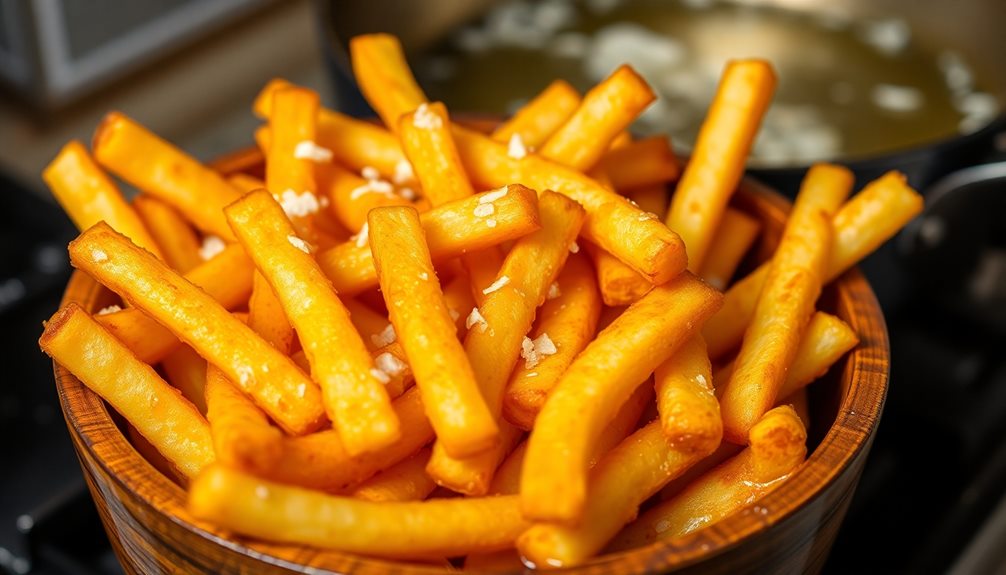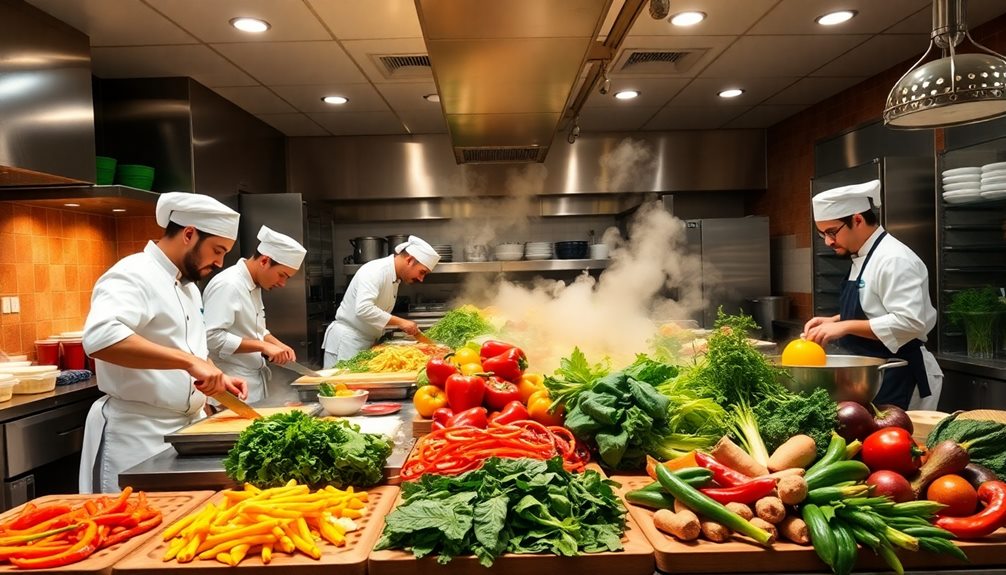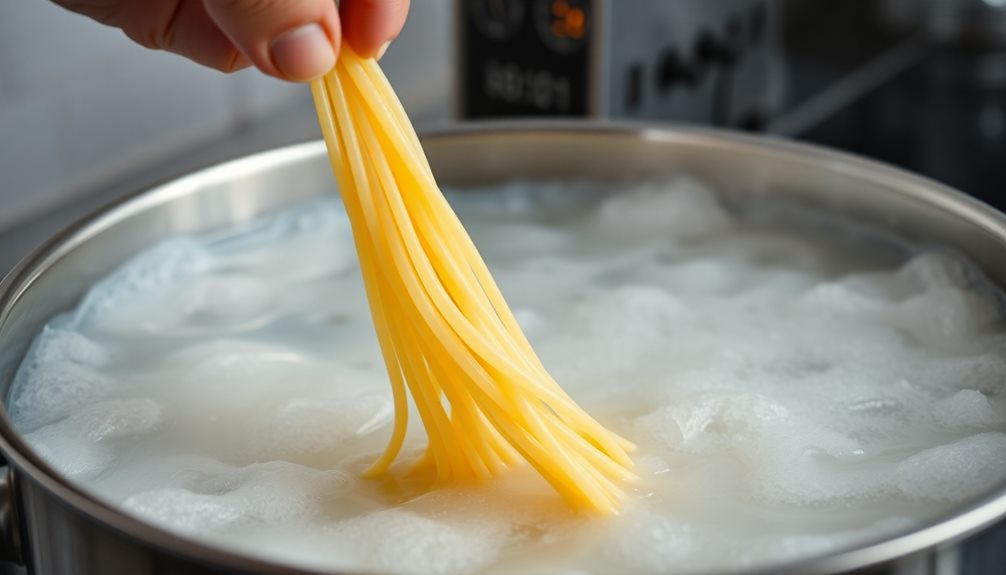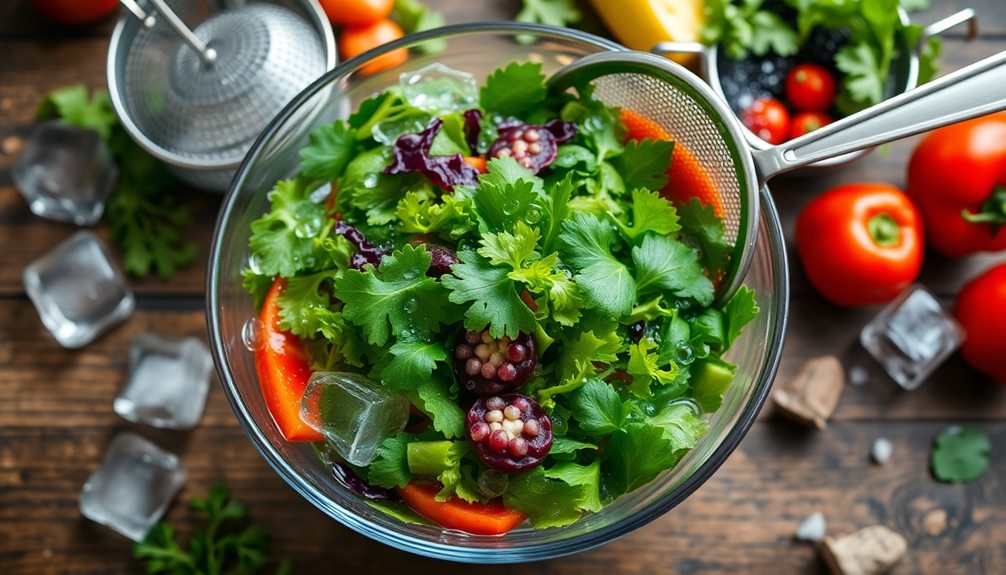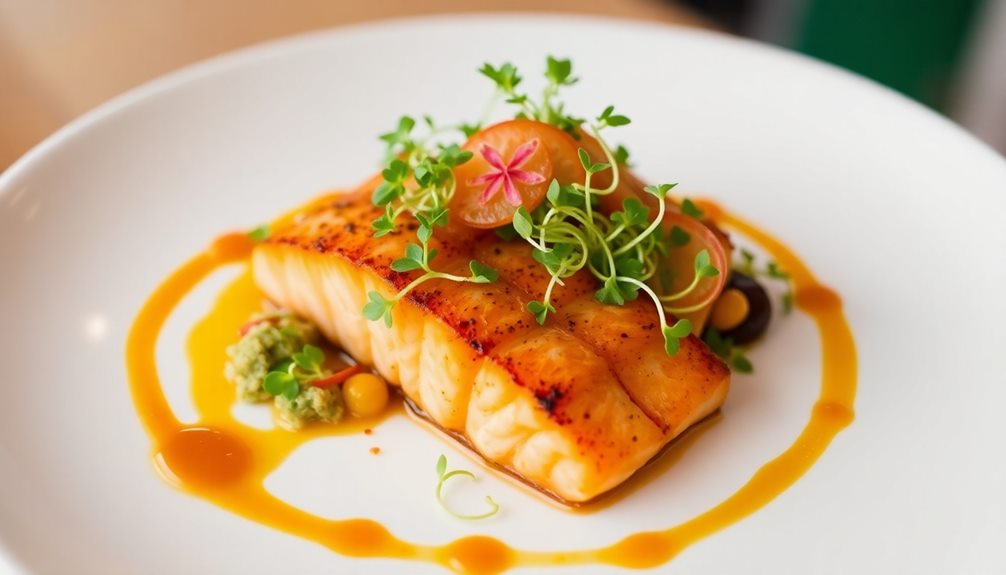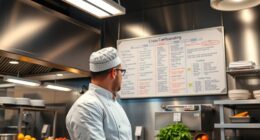Restaurants cook steaks perfectly by starting with high-quality beef, like USDA Prime, and utilizing aging techniques to enhance flavor and tenderness. They season simply with kosher salt and black pepper. High-temperature cooking methods, such as searing in cast iron pans or using infrared broilers, create that desirable crust via the Maillard reaction. Monitoring the steak's internal temperature guarantees it's cooked just right, while letting it rest afterward allows juices to redistribute. With all these expert techniques, you can achieve restaurant-quality steaks at home. Stick around for more tips on elevating your steak-cooking game!
Key Takeaways
- Restaurants often use high-quality cuts, such as USDA Prime or Choice grade beef, to ensure tenderness and flavor in steaks.
- Aging methods like dry or wet aging enhance flavor and tenderness, providing a superior dining experience.
- High-temperature searing creates a flavorful crust through the Maillard reaction, locking in juices for a tender result.
- Proper seasoning with kosher salt and coarse black pepper enhances natural flavors without overpowering the steak.
- Allowing steaks to rest post-cooking redistributes juices, resulting in a juicier and more flavorful steak.
Understanding Steak Grades
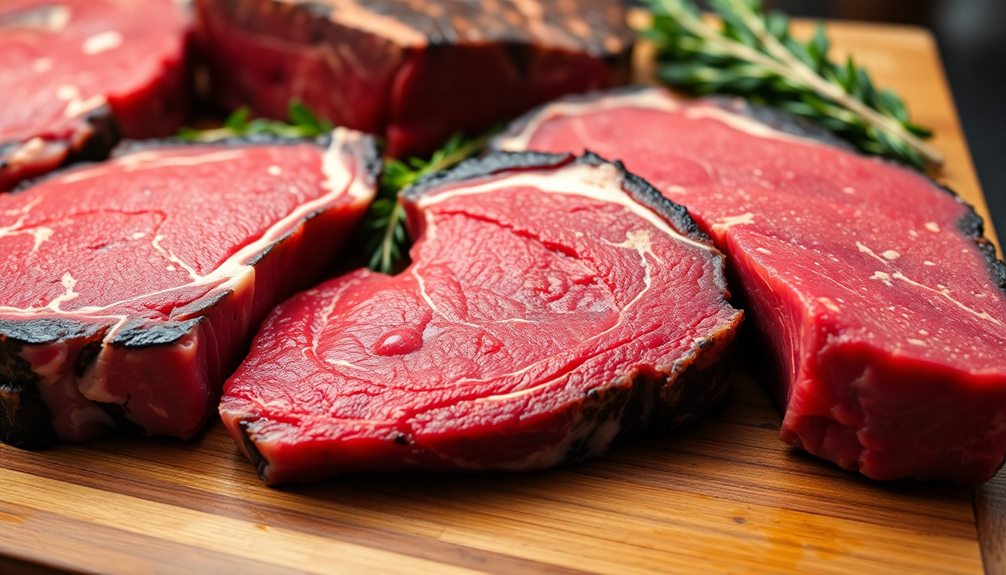
When you're shopping for steaks, understanding the different grades of beef can greatly impact your cooking experience. The USDA grading system helps you choose the right steak for your meal.
At the top, you've got USDA Prime beef, which makes up only about 2% of total beef production in the U.S. This grade is sought after by fine dining establishments for its outstanding marbling and tenderness, making it the ideal choice for special occasions.
However, if you're looking for something more accessible, consider Choice grade beef. It strikes a balance between quality and price, offering a delicious option for home cooks without breaking the bank. While you may find Prime beef in upscale grocery stores or restaurants, Choice is more readily available.
Many countries have similar grading systems, reflecting the global appreciation for high-quality steak. By understanding these grades, you can make informed choices when selecting steak for your next cookout or dinner.
Keep these distinctions in mind, and you'll elevate your cooking game, ensuring that each steak you prepare is a satisfying experience.
The Aging Process
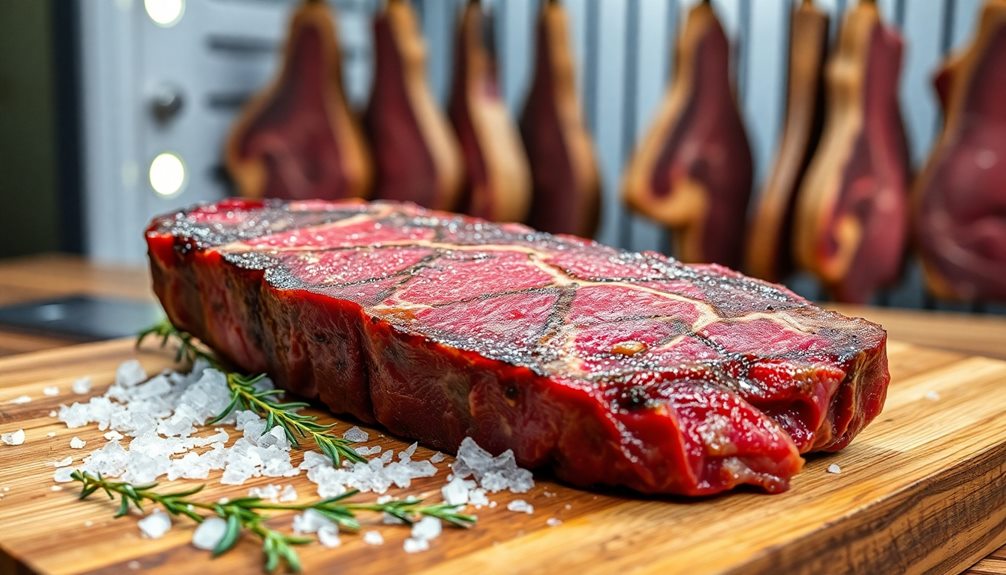
Aging beef can greatly boost its flavor and tenderness, making it a popular choice among steak lovers.
You'll find various aging methods, with dry aging being a standout for its rich taste.
However, be aware of the risks involved, as improper aging can lead to spoilage and food safety concerns.
Benefits of Dry Aging
There's something special about dry aging beef that elevates it beyond the ordinary. This process typically lasts from several days to weeks, allowing natural enzymes to break down muscle tissue. As a result, you'll experience enhanced flavor and tenderness in every bite.
When you choose dry aging beef, you're opting for a concentrated flavor profile, as the moisture content reduces, intensifying the taste. Controlled aging conditions are vital to this transformation. Maintaining the right temperature and humidity prevents spoilage, ensuring the meat remains safe to enjoy.
While you might find dry-aged beef in high-end restaurants, local meat markets often offer aged options for home cooks like you who seek quality.
It's worth noting that while dry aging beef delivers undeniable benefits, you can still achieve a quality steak without this process. By selecting the right cuts and using effective cooking techniques, you can create a delicious steak experience.
However, when you do indulge in dry-aged beef, you're treating yourself to a premium product that truly showcases what great steak can be. Enjoy the journey of discovering these remarkable flavors!
Aging Methods Explained
Understanding the aging process is key to appreciating the superior qualities of beef. Aging methods enhance flavor and tenderness through moisture evaporation and natural enzymatic action. There are two primary aging techniques you should know: dry aging and wet aging.
- Dry Aging: Beef is exposed to air in a temperature-controlled environment, resulting in a concentrated flavor and unique texture.
- Wet Aging: Beef is vacuum-sealed and stored in its own juices, allowing it to age without exposure to air.
- Flavor Concentration: Dry aging intensifies beef's taste, making it a favorite among steak lovers.
- Moisture Loss: During aging, moisture evaporates, which helps create that rich, beefy flavor.
- Controlled Conditions: Both methods require specific temperatures and humidity levels to minimize spoilage risks.
While dry aging can elevate your steak experience, it also poses challenges, especially for home cooks. Local meat markets often offer aged beef, so you can enjoy the benefits without the hassle.
However, remember that you can achieve high-quality steaks with well-marbled cuts and proper cooking techniques, even without aging.
Risks of Aging Meat
Steering through the world of meat aging comes with significant risks, especially for home cooks. While aging beef can enhance flavor and tenderness through the breakdown of muscle tissue, it requires controlled conditions to prevent spoilage.
The aging process typically lasts from several days to weeks, with dry aging being the most common method used in restaurants. However, this method is particularly challenging due to the potential for spoilage.
When you attempt to age meat at home, you open yourself up to the dangers of food poisoning. Precise temperature and humidity controls are essential, and without them, you risk ruining the meat or making it unsafe to eat.
Instead of aging beef yourself, consider visiting local meat markets that offer aged options. This way, you can enjoy the benefits of aged meat without the associated risks.
Key Seasoning Techniques
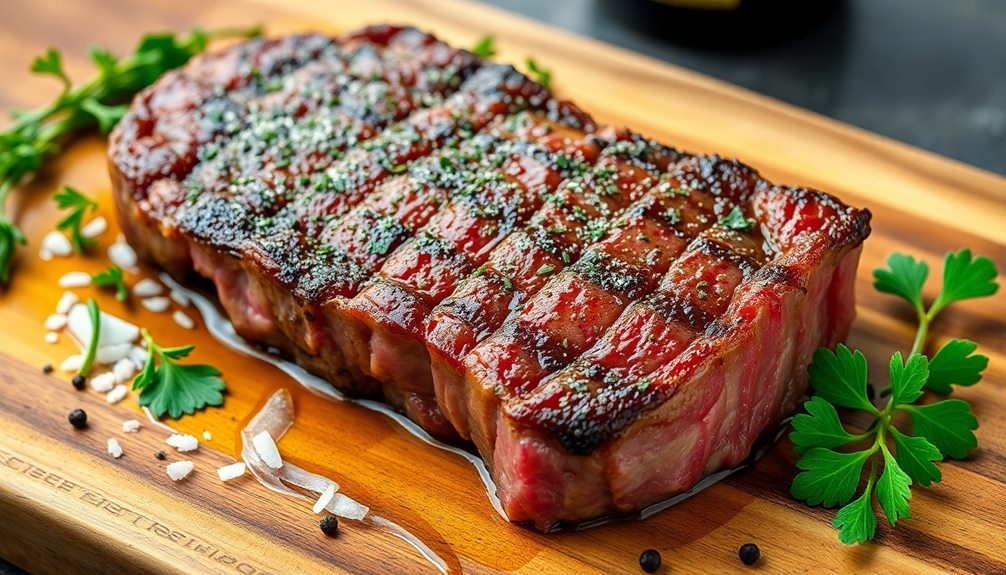
Seasoning your steak properly is essential for bringing out its natural flavors and creating a mouthwatering dish. The right balance of seasonings can elevate your steak experience, allowing the quality of the meat to shine.
Here are key techniques to master:
- Use kosher salt: It enhances the meat's natural flavors without overpowering them.
- Coarse ground black pepper: This adds a nice kick and complements the salt perfectly.
- Butter: Adding it at the right time can enrich the flavor, making your steak more decadent.
- Simple seasoning: Sometimes, less is more. Just salt and pepper can be enough for a classic steak.
- Finish with coarse sea salt: Sprinkling it just before serving provides a delightful texture contrast and enhances the overall flavor profile.
Essential Cooking Equipment
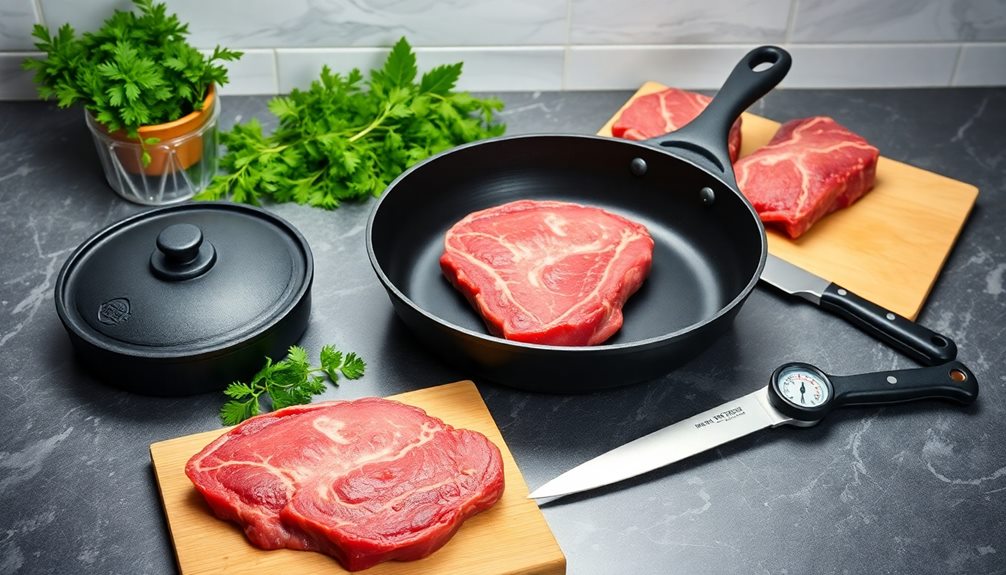
Having the right cooking equipment is essential for achieving that perfectly cooked steak. One of the best tools you can have in your kitchen is a cast iron pan. This heavy-duty skillet excels in heat retention, allowing you to create a beautiful sear on your steak, which enhances its flavor.
Additionally, understanding the role of color accuracy in projection can be paralleled with guaranteeing the right temperature control for even cooking, as both elements contribute greatly to the final outcome.
While many high-end steakhouses utilize infrared broilers for intense heat and direct contact with the meat, you can still achieve impressive results at home with quality equipment. A well-seasoned cast iron pan not only helps with caramelization, but it also guarantees consistent cooking performance.
If you're looking for versatility, consider heavy frying pans as well. They can provide excellent heat distribution, making them ideal for searing and finishing steaks.
Although grilling is popular, broiling offers more precise temperature control, a technique that many restaurants prefer.
Cooking Methods Explained
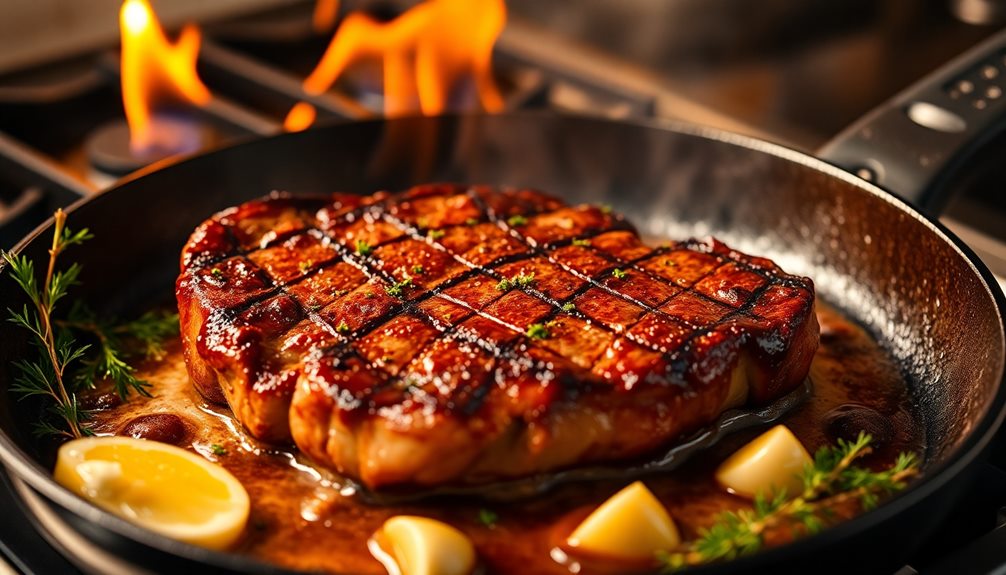
When it comes to cooking steaks, high-temperature techniques are key to revealing incredible flavor.
Searing your steak not only enhances its taste but also creates that mouthwatering crust you love.
Don't forget to rest your steak afterward; it's essential for juicy, tender results.
High-Temperature Cooking Techniques
High-temperature cooking techniques are vital for achieving that perfect steak sear and flavor. When you cook at high heat, you're not just cooking; you're creating a delicious crust through the Maillard reaction, which enhances the steak's overall taste.
Restaurants often use specialized tools to achieve this, guaranteeing your steak is cooked to perfection.
- Infrared broilers: Generate extremely high temperatures for a flawless sear and caramelization.
- Cast iron skillets: Known for their excellent heat retention, they help deliver effective searing.
- Grilling techniques: Proper management of flare-ups by adjusting the distance to coals is essential.
- Water usage: Spraying water can help reduce flame intensity, allowing for better control.
- Finishing under a broiler: Many steakhouses complete cooking steaks in a broiler to achieve desired doneness while locking in moisture.
Utilizing these high-temperature methods, restaurants guarantee that each steak not only looks appealing but also bursts with flavor.
Searing for Flavor Enhancement
Achieving the perfect steak isn't just about the cooking method; it's also about how you sear it. Searing at high temperatures creates a Maillard reaction, which brings out the rich flavors of the meat and forms a delicious caramelized crust. To get that intense heat, restaurants often use infrared broilers or cast iron pans, ensuring your steak gets the sear it deserves.
Before you start, season your steak generously with sea salt. This not only enhances the flavor but also helps with the crust formation.
Once you place the steak in the hot pan, resist the urge to flip it too often. Let it sear undisturbed to achieve even cooking and ideal caramelization on the surface.
As the steak nears completion, consider adding a pat of butter. This enriches the flavor and helps baste the meat, giving it a sumptuous finish.
Remember, searing not only adds depth of flavor but also locks in those delicious juices, resulting in a tender steak that's sure to impress.
Resting for Optimal Juiciness
Resting your steak is just as essential as the cooking process itself. When you finish cooking, give it at least ten minutes of rest. This allows the juices to redistribute throughout the meat, resulting in a more flavorful and juicy bite. The ideal resting temperature for a medium-rare steak is around 140°F, which helps maintain doneness while keeping moisture intact.
Here are some tips for resting steak for peak juiciness:
- Cover loosely: Use aluminum foil to retain heat without steaming the exterior.
- Choose the right surface: Rest on a cutting board or plate to absorb excess juices.
- Resist the urge: Avoid cutting into the steak too soon; let it relax.
- Timing matters: The longer the steak rests (up to 15-20 minutes), the better the results.
- Know your doneness: Adjust resting times according to your preferred doneness level.
Failing to rest adequately can lead to a dry, less flavorful steak, as the juices will run out when you cut too soon.
Monitoring Cooking Progress
When it comes to cooking steaks perfectly, monitoring progress is essential to avoid overcooking and confirm you hit that ideal doneness. Restaurants often rely on several methods to confirm their steaks are cooked just right. Instant-read thermometers are a chef's best friend, providing an accurate internal temperature without cutting into the meat.
Timing also plays a critical role; professional chefs track cooking times based on steak thickness and heat source. Visual cues, such as color and juices, offer additional insights. A well-cooked steak exhibits a rich brown crust and clear juices as it nears completion.
Many chefs employ the "finger test" technique, comparing the steak's firmness to the palm of their hand to gauge doneness. Here's a quick reference to help you visualize these techniques:
| Technique | Description |
|---|---|
| Instant-Read Thermometer | Measures internal temperature accurately |
| Timing | Follows specific times based on thickness |
| Visual Cues | Looks for crust color and clear juices |
| Finger Test | Compares firmness to palm |
| Experience | Relies on chef's instincts and knowledge |
Importance of Resting
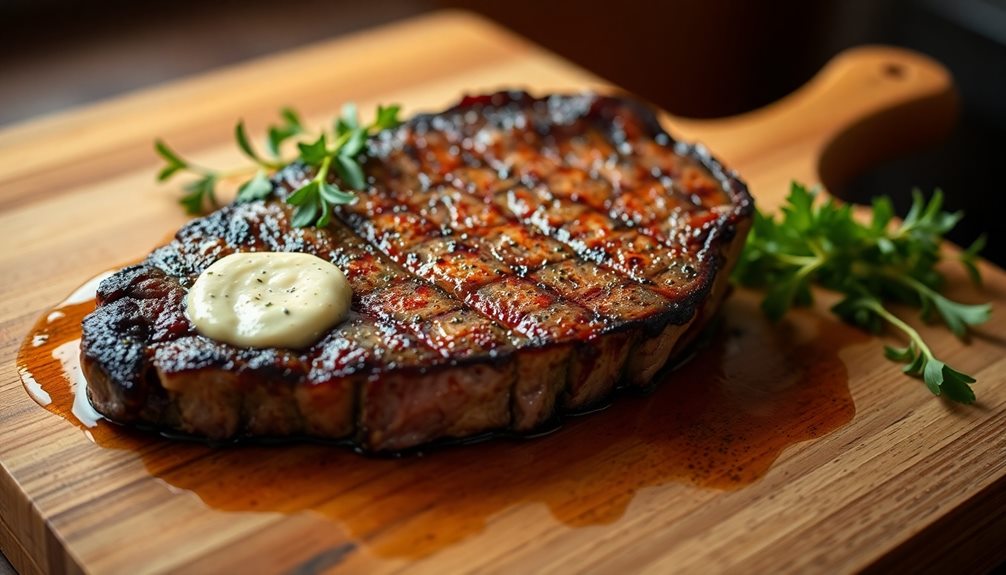
To guarantee your steak is as juicy and flavorful as possible, letting it rest for at least ten minutes after cooking is essential.
When you cook steak, the heat pushes the juices away from the center. Resting steak allows those juices to redistribute, preventing a dry experience when you make that first cut. If you skip this step, you could lose up to 30% of the juices, which definitely affects the taste.
Here are a few reasons why resting steak matters:
- Juice Redistribution: Juices move back into the meat, enhancing moisture.
- Temperature Rise: The steak can increase in temperature by 5-10 degrees, achieving perfect doneness.
- Flavor Development: The Maillard reaction flavors deepen during resting, boosting taste.
- Improved Texture: Resting makes the steak more tender, making each bite enjoyable.
- Preventing Overcooking: It protects against the steak being overdone while resting.
Common Steak Cuts
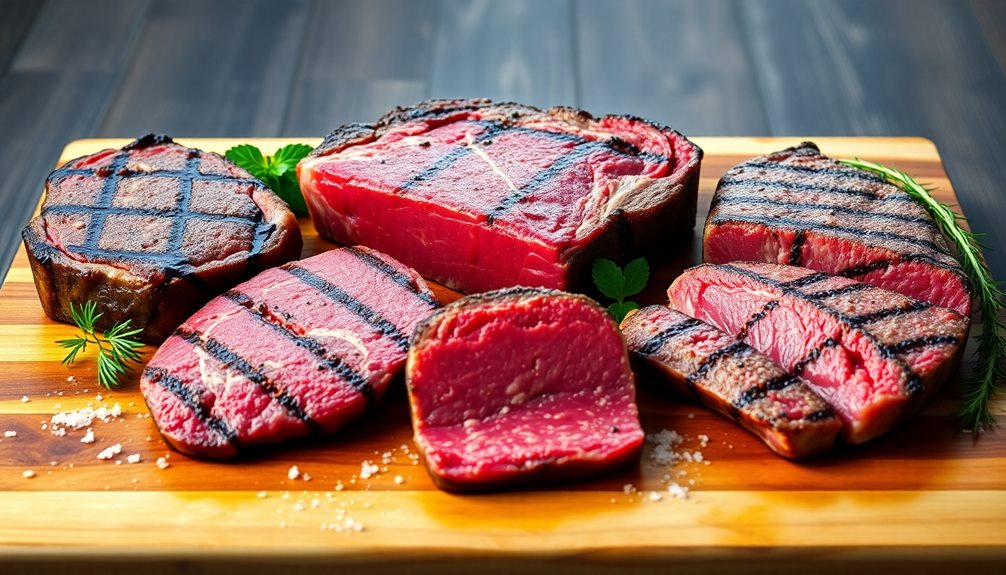
Understanding the different cuts of steak can elevate your cooking game and help you choose the right one for your meal. Each cut has its unique flavor profile and texture, making it essential to know what you're working with.
Here's a quick overview of some common cuts:
| Steak Cut | Flavor Profile | Best Cooking Method |
|---|---|---|
| Rib-eye | Rich marbling, flavorful | Grilling, pan-searing |
| New York Strip | Tender, balanced flavor | Grilling, broiling |
| Filet Mignon | Buttery tenderness | Searing, roasting |
| Flank Steak | Flavorful, tougher | Marinating, grilling |
| Tomahawk Steak | Dramatic, rich flavor | Slow roasting, grilling |
The New York strip is a popular choice in steakhouses due to its excellent balance of tenderness and taste. If you prefer something more tender, the filet mignon is often considered the most luxurious cut. For a heartier option, try the rib-eye or the impressive tomahawk steak. Each cut can create a memorable meal when cooked properly, so choose wisely!
Expert Tips From Chefs
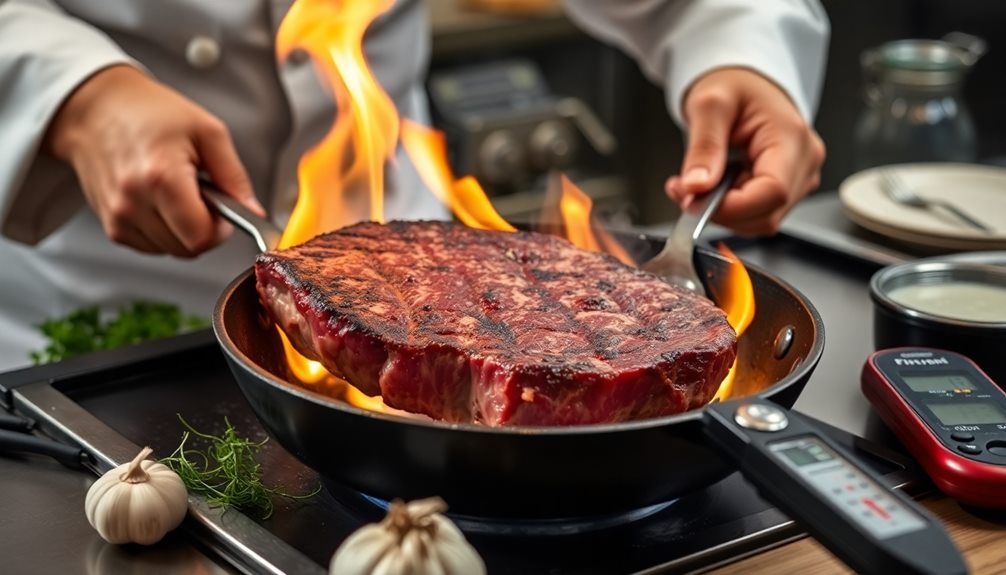
For perfecting your steak, expert chefs offer invaluable insights that can transform your home cooking. First and foremost, selecting good quality meat is essential. Aim for USDA Prime or well-marbled cuts like rib-eye to guarantee superior flavor and tenderness.
Here are some tips to elevate your steak game:
- Bring it to room temperature: Let your steak sit out for about 30 minutes before cooking to promote even cooking.
- Focus on the Maillard reaction: Preheat your grill or pan to high temperatures to create that delicious char and flavor.
- Minimize flipping: Resist the urge to flip your steak often; allow it to develop a nice crust by flipping only once.
- Use a meat thermometer: Check for doneness without cutting into your steak; aim for 130°F for medium-rare.
- Finish with flavor: During resting, drizzle a mixture of stock and butter over your steak to enhance flavor absorption.
Frequently Asked Questions
How Do Most Restaurants Cook Their Steaks?
Most restaurants cook their steaks by using high-heat infrared broilers or hot grills, allowing for a perfect sear. They season simply, choose quality cuts, and rest the meat to guarantee juicy, flavorful results.
How Do Steakhouses Cook Steak so Fast?
Steakhouses cook steaks fast by using high-temperature infrared broilers and heavy-duty cast iron pans. They also bring steaks to room temperature beforehand, allowing for quick cooking while ensuring even doneness and ideal flavor.
What Do Chefs Think Is the Best Way to Cook Steak?
Did you know that 60% of chefs swear by high-quality meat for the best steak? They recommend bringing it to room temperature, searing it hot, adding butter, and resting it to maximize flavor and tenderness.
What Do Restaurants Put on Steaks to Make Them Taste so Good?
Restaurants enhance steak flavors by using coarse kosher salt and black pepper for seasoning. They often finish with brown butter, fresh herbs, and aromatics, creating a rich, aromatic profile that elevates the overall taste experience.
Conclusion
To cook steaks perfectly, remember that over 70% of diners believe the quality of the meat is the most important factor in their dining experience. By understanding steak grades, using proper seasoning, and mastering cooking techniques, you can elevate your steak game. Don't forget to rest your steak before slicing; it's essential for juicy results. With practice and attention to detail, you'll impress everyone at the table with your steak-cooking skills!

